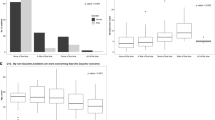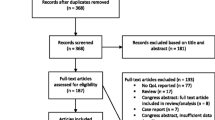Abstract
The impact of type 1 Gaucher disease and its therapy on health-related quality of life (QOL) was investigated and the results were compared with a Spanish adult normative group. Patients and Methods: Between January 1998 and December 2002, a prospective clinical QOL trial was conducted by application of a Spanish version of the Health Survey SF-36 questionnaire. Patients receiving ERT (69 cases) filled in the questionnaire two times, prior to starting ERT and after two years under ERT. The patients were stratified by gender and age group. Clinical and X-ray data to assess bone disease were obtained from the Spanish Gaucher Register. Demographic, clinical, genotype and analytical data and the response to therapy were evaluated. Four grades of severity were established according to bone disease (no symptoms=0, moderate bone pain=1, severe bone crisis=2, fracture/necrosis=3). Correlation analysis was made between QOL score and grade of bone disease. Results: Mean age ± SD 33.6 ± 11.7 (range 18–66), M/F ratio 33/36; bone disease: 0 in 27 patients (47.3%), 1 in 11 (19.3%), 2 in 5 (8.8%) and 3 in 14 (24.5%). Physical activity: 11 patients (19.3%) showed severe restriction and 41 patients (71.9%) were only limited for strenuous activities. The mean score for QOL questionnaire was 11.9 ± 10.4 (range 2–46). Correlation between score and bone disease was significant only for 1 and 3 grades (p=0.02). Improvement in self perception of global health was observed ranging from 34.3% before ERT to 91.4% after ERT ( p=0.001). Nevertheless physical activity remained unsatisfactory in 24.5% of patients due mainly to bone sequelae. Comments: Physical activities and bone disease grade 1 and 3 are negatively related to QOL. Nevertheless no correlation was found with bone pain crisis, possibly due to the transitory character of this event. In spite of the improvement induced by ERT, a quarter of patients remained with physical limitations related to bone disease as well as in need of orthopaedic correction of bone sequelae. In order to improve the QOL an accurate evaluation of bone disease to define therapeutic approaches must be considered.
Similar content being viewed by others
Abbreviations
- GD:
-
Gaucher diseases
- QOL:
-
Quality of life
- SF-36:
-
Short form 36 scales
- ERT:
-
enzymatic replacement therapy
- GBA:
-
glucocerebrosidase
References
E Beutler GA Graboski (2001) Gaucher disease CR Scriver AL Beaudet WS Sly D Valle (Eds) The Metabolic and Molecular Basis of Inherited Disease. EditionNumber8 McGraw-Hill New York 3635–3668
Alfonso P, Pocoví M. Genética de la enfermedad de Gaucher. Correlación genotipo-fenotipo. En: Giraldo P, Giralt M, Pocovi M, Pérez-Calvo J (eds), Enfermedad de Gaucher. 2ª Ed Zaragoza 2003; pp. 129–150.
E Beutler AM Garber (1994) ArticleTitleAlglucerase for Gaucher’s disease: Dose, cost and benefits. Pharmacoeconomics 5 453–459
Technology Assessment Panel on Gaucher Disease NIH (1996) ArticleTitleGaucher disease: Current issues in diagnosis and treatment. J Am Med Assoc 275 548–553
American Medical Association. Principles of Outcomes Research. Outcomes Research Resource Guide, 1996/97. American Medical Association 1997.
AE Clarke MK Goldstein D Michelson AM Garber LA Lennert (1997) ArticleTitleThe effect of assessment method and respondent population on utilities elicited for Gaucher disease. Qual Life Res 6 169–184
AM Damiano GM Pastores JE Ware (1998) ArticleTitleThe health related quality of life of adults with Gaucher’s disease receiving enzyme replacement therapy: Results from a retrospective study. Qual Life Res 7 373–386
BJ Masek KB Sims CM Bove MS Korson P Short DK Norman (1999) ArticleTitleQuality of life assessment in adults with type 1 Gaucher disease. Qual life Res 8 263–268
GM Pastores (2002) ArticleTitleQuality of life assessment: To measure the health-related burden of Gaucher disease and treatment outcome. Clin Perspect Lysosomal Storage Disorders 10 16–19
Giraldo P, Chabás A, Pérez-Calvo J, Epidemiología de la Enfermedad de Gaucher en España. En Giraldo P, Giralt M, Pocovi M, Pérez-Calvo J (eds), Enfermedad de Gaucher. 2ª Ed Zaragoza 2003; 39–56.
L Alonso J Prieto JM Antó (1995) ArticleTitleLa versión española del SF-36 Health Survey (Cuestionario de Salud SF-36): Un instrumento para la medida de los resultados clínicos. Med Clin (Barc) 104 771–776
Badia X, Salamero M, Alonso J. La medida de la salud. Guía de escalas en español. Barcelona: Edimac, 1999.
Giraldo P, Giralt M, Pocovi M, Pérez-Calvo J. Guía de actuación en pacientes adultos con Enfermedad de Gaucher tipo 1. En: Giraldo P, Giralt M, Pocovi M, Pérez-Calvo J (eds), Enfermedad de Gaucher. 2ª Ed Zaragoza 2003; 269–276.
N González A Padierna JM Quintana L Aróstegui MJ Horcajo (2001) ArticleTitleCalidad de vida de los pacientes afectados de trastornos de la alimentación. Gac Sanit 15 18–24
Author information
Authors and Affiliations
Corresponding author
Additional information
Spanish Group on Gaucher disease
Rights and permissions
About this article
Cite this article
Giraldo, P., Solano, V., Pérez-Calvo, JI. et al. Quality of life related to type 1 Gaucher disease: Spanish experience. Qual Life Res 14, 453–461 (2005). https://doi.org/10.1007/s11136-004-0794-y
Accepted:
Issue Date:
DOI: https://doi.org/10.1007/s11136-004-0794-y




